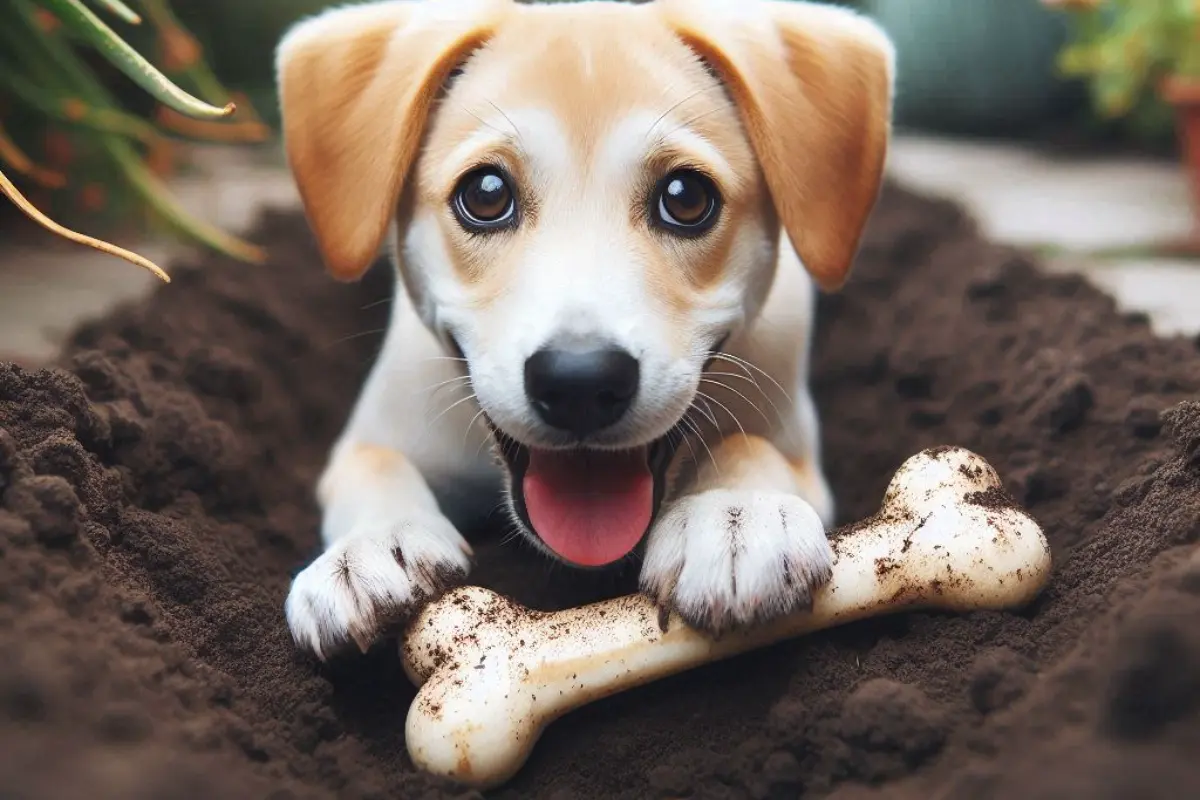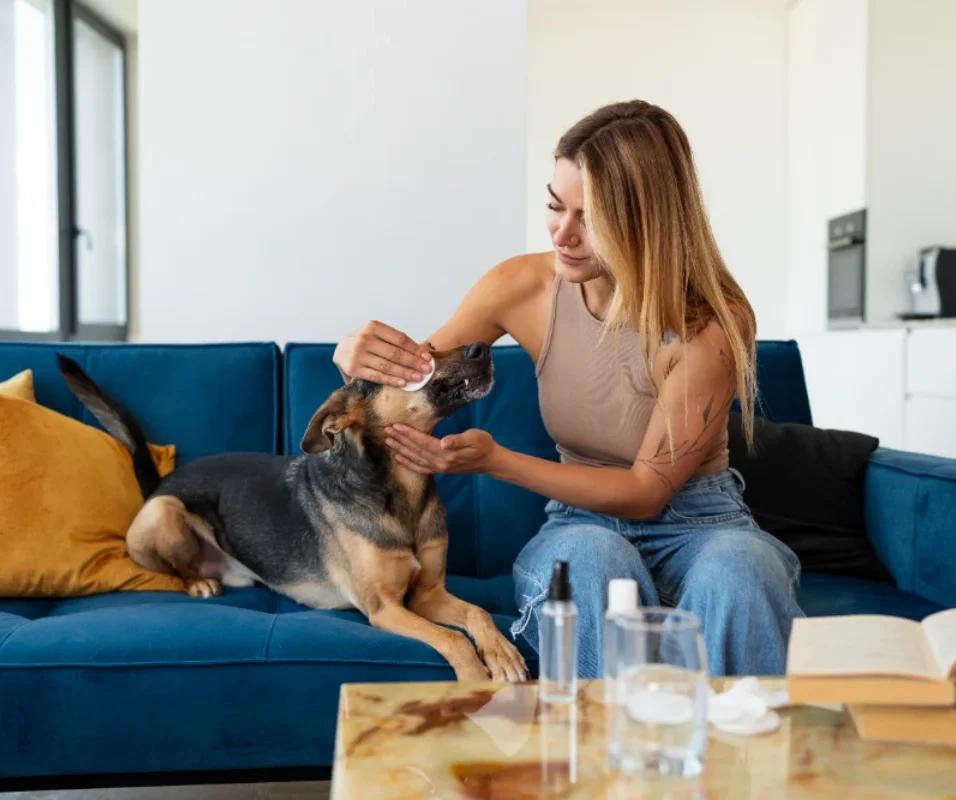Does your dog have a habit of burying bones or other stolen items?
Sometimes, this behaviour is funny, even delightful. But when your flowerbeds or couch cushions suffer, you might start to feel frustrated and wonder why your dog buries bones, treats, and toys in the garden—or in piles of freshly washed laundry!
This Blog will explore the reasons behind treat hiding and various products and services designed to help manage this curious canine behaviour.
Why Do Dogs Hide their treats? Find Reasons Behind
Dogs come directly from wolves, but dogs have developed their unique personality as a species for thousands of years. Many dogs have a habit–good or bad–of hiding treats that they are given.

Many dog parents wonder why their dogs do this. Some think it might be bad behaviour. Well, if your dog is hiding treats that you give them unless it is too much, this isn’t something that you have to worry about.
Few sights are as heartbreaking to a dog owner as seeing a scared dog, especially when the dog is afraid of you. That can make any owner feel completely helpless and without a clue about what to do.
If you’re thinking to yourself, “My dog is scared of me” and are desperate for answers, you’ve come to the right place – in this article, we’ll go over some of the most important aspects of fearful dog training and products that can help you learn how to manage the situation.
Services That Can Help
Dogs Training
Training can help prevent or manage behavioural problems, a common reason dogs are given up or put to sleep. It can also help dogs be more patient, self-controlled, and consistent in their behaviour.
1. Positive Reinforcement Training
Positive reinforcement training uses a reward for desired behaviors. Because the reward makes them more likely to repeat the behavior, positive reinforcement is one of your most powerful tools for shaping or changing your dog’s behavior.
- Pros
- Positive reinforcement training strengthens the bond between you and your dog by building.
- This method encourages good behavior through rewards, making it an effective approach for long-term behavioral improvements.
- Cons.
- This training approach requires significant time and patience.
- Behavior changes are gradual and depend on consistent reinforcement and practice.
2. Professional Dog behaviorists
A Professional Dog behaviorist can offer valuable insights into why your dog hides treats and toys. Their expertise can help you understand your dog’s instincts and behavior’s, offering strategies to manage and redirect this natural tendency.
- Pros.
- A Professional Dog behaviorists provides customized strategies based on your dog’s unique behavior.
- Their expertise is particularly beneficial for addressing complex or severe behavioral problems and offering targeted solutions and guidance.
- Cons.
- Sessions with a behaviorist can be costly, and resolving behavioral issues may require multiple visits
- Potentially making it a more time-consuming and expensive option compared to other methods.
Products That Can Help
Interactive Toys
Interactive toys such as puzzles, building blocks and other similar games – encourage mental development in children from a young age. They will start to recognize shapes and colours, patterns and numbers, as well as many different things.
1. Kong Classic Chewing Toy
The KONG Classic chewing toy helps satisfy dogs’ natural needs and provides mental stimulation. The toy helps solve chewing, teething, boredom, crate training, digging, barking and more.

- Pros.
- The Kong Classic is known for its durability and ability to engage dogs in prolonged play.
- Its design can help reduce boredom and prevent destructive behaviors by keeping dogs mentally and physically stimulated.
- Cons.
- While the Kong Classic is robust, it might be too hard for some dogs, particularly those with sensitive teeth or jaws.
- The toy may not hold up well over time and could potentially be less effective in managing their chewing needs.
2. Outward Hound Puzzle Toy
The Outward Hound Puzzle Toy is designed to keep your dog entertained and mentally stimulated. Its interactive features require your dog to solve puzzles to access treats or kibble, making playtime both fun and challenging.

- Pros.
- The Outward Hound Puzzle Toy offers an engaging challenge that stimulates your dog’s mind and encourages problem-solving skills.
- It provides a fun way for your dog to stay mentally active and can help alleviate boredom.
- Cons.
- This toy requires supervision during play to ensure your dog doesn’t become frustrated or overly rough.
- If your dog is particularly aggressive or determined, the toy may wear out or break faster than expected.
Which One Is Better?
Both the Kong Classic Chewing and Outward Hound Puzzle Toy offer unique benefits tailored to different needs. The Kong Classic excels in durability and provides lasting engagement through treat stuffing, making it perfect for tough chewers who need a durable plaything.
On the other hand, the Outward Hound Puzzle Toy challenges your dog’s mind with interactive puzzles, ideal for mental stimulation and reducing dullness.
If your dog thrives on physical durability and chew resistance, go for the Kong Classic. For a mentally stimulating experience that keeps your dog’s brain active, the Outward Hound Puzzle Toy is the way to go.
Treat Containers
1. IRIS Airtight Pet Food Container
The IRIS Airtight Pet Food Container is a practical solution for pet owners who want to keep their dog’s food and treats fresh and accessible. Its airtight seal ensures that the food stays fresh by locking the smell and moisture, preventing your dog from sniffing out their favourite treats and potentially hiding them around the house.

- Pros.
- The IRIS Airtight Pet Food Container is designed to keep your dog’s treats and food fresh.
- Its airtight design is also great for maintaining the quality of the food over time.
- Cons.
- The container might be too large for those with limited storage space, making it less convenient in smaller living areas.
2. Vittles Vault Outback Food Storage
This airtight container for dogs is easy to fill and open with a screw-on top that will keep your pet’s food fresh. There are several sizes available so that you can choose a capacity that best fits your pet’s needs. Although it comes with a higher price tag compared to other containers, its longevity and effectiveness in preserving food quality make it a worthwhile investment for those who want the best for their pets.

- Pros.
- The Vittles Vault Outback Food Storage offers a robust, durable design with a tight seal that keeps food fresh and prevents pests from getting inside.
- Its sturdy construction ensures it lasts a long time, making it a reliable investment for pet owners.
- Cons.
- It tends to be more expensive compared to other food storage containers, which might be a drawback for budget-conscious buyers.
Comparison
Both the IRIS Airtight Pet Food Container and the Vittles Vault Outback are excellent choices for keeping treats fresh and preventing your dog from catching the scent, reducing the likelihood of treat hiding. If you need a compact solution, the IRIS container might be better, but for long-lasting durability and pest prevention, the Vittles Vault is worth the investment.
Simple DIY Solutions
DIY Treat Toys
1. Homemade Treat Ball
A Homemade Treat Ball is a DIY project, which is simple and can keep your dogs entertained for a long. The main idea is to make a ball-shaped thing with household things like old tennis balls or hard plastic bottles, placing some treats inside it. It keeps the dog entertained by allowing small treats to fall out as they play with the ball or bottle making them try to get hold of the food items inside.

- Pros.
- The best thing about Homemade Treat Ball is that it is inexpensive and can be custom-made according to the size of your pet.
- You can select materials that are safe and soft for your dog’s teeth to chew on as well as adjust difficulty levels.
- Cons.
- the negative side of homemade treat balls can be durability when compared to store-bought versions.
- if your dog likes chewing on objects aggressively, then the ball may not last very long and you might have to frequently fix it or buy new ones altogether.
2. Hide-and-Seek Games
Hide-and-seek games are a fantastic way to engage your dog’s natural behave and provide them with mental stimulation. The concept is simple: you hide treats or toys around the house or yard, and your dog has to use their sense of smell and problem-solving skills to find them. This type of game taps into a dog’s natural foraging behavior, making it both fun and fulfilling.
- Pros.
- These games are also a great way to bond with your dog.
- It’s a highly interactive activity that can be adapted to your dog’s skill level and environment.
- Cons.
- On the downside, Hide-and-Seek Games require more time and effort on your part compared to other toys.
- It’s best suited for pet owners who enjoy spending quality time playing with their dogs and can dedicate the necessary time to setting up and guiding the game.
Comparison
Both DIY options offer unique benefits that can keep your dog entertained and mentally stimulated. The Homemade Treat Ball is a quick and customizable project, ideal for those looking for an easy and inexpensive way to engage their dog.
On the other hand, Hide-and-Seek Games offer a deeper level of interaction and use your dog’s instincts, making them perfect for owners who enjoy spending time playing with their pets.
Combining Products and Services
Balanced Approach
Combining products and services is an effective way to tackle both the physical and emotional aspects of your dog’s behaviour, particularly when it comes to treating hiding. This approach ensures that you address basic issues like anxiety or boredom while also providing practical solutions that healthily engage your dog.
Example.
One practical way to combine products and services is by using a treat-dispensing toy, like the Kong Classic, alongside positive reinforcement training. For instance, you can fill the Kong with your dog’s favourite treats and use it during training sessions to reward good behaviour.
This not only keeps your dog engaged but also teaches them to associate the toy with positive experiences, reducing their need to hide treats out of anxiety or boredom.
Tips.
1. Stick to a routine
Consistency is key when combining products and services. Establish a routine that incorporates both playtime with the treat-dispensing toy and training sessions.
2. Keep Track of Progress
Monitor your dog’s behaviour over time to see how they respond to the combined approach. Take note of any improvements in their behaviour, such as less threat hiding or more engagement during play and training.
Conclusion
Dogs often hide treats as an instinct, rooted in their Inherited behaviour to store food for later. Throughout this blog, we explored various products and services that can help manage this behaviour, from durable treat-storing containers like the IRIS Airtight Pet Food Container and Vittles Vault Outback to engaging DIY toys and professional behaviourist advice.

When choosing products or services to address your dog’s habit of hiding treats, consider what best suits your dog’s needs. Do you ever think that why your dog lick their paws?
Ready to help your dog control their treat-hiding habit? Try out one of the recommended products or, if you’re dealing with more serious behavior.








